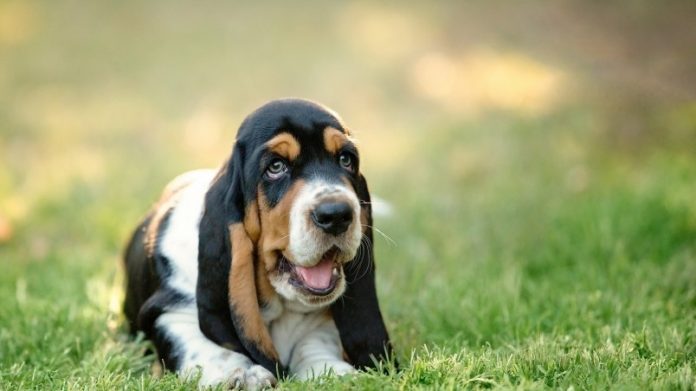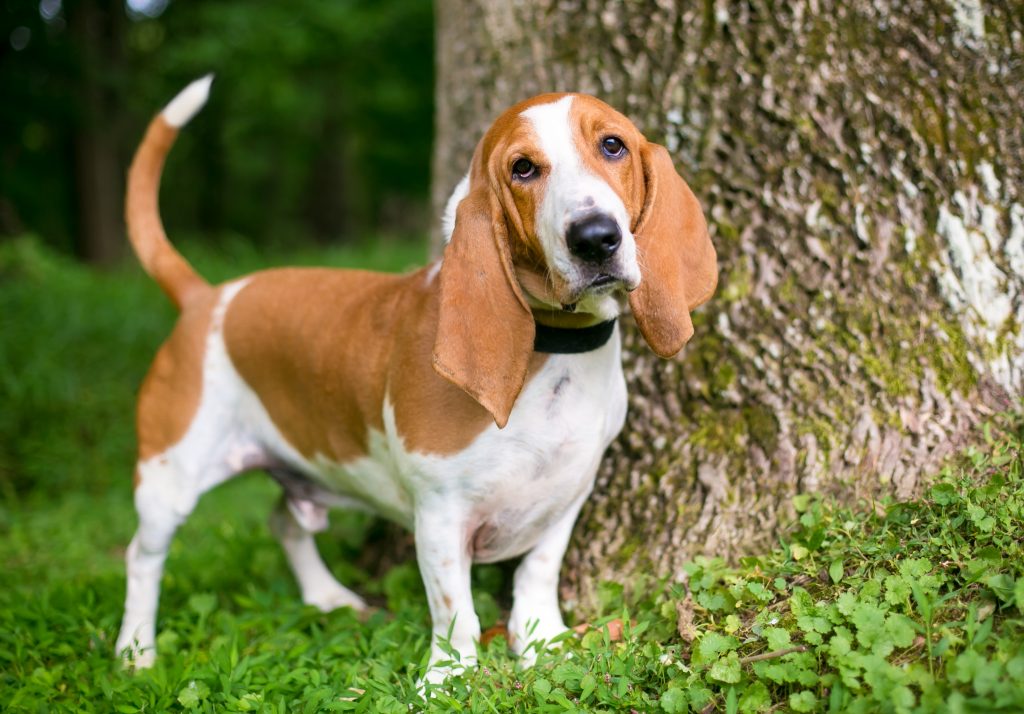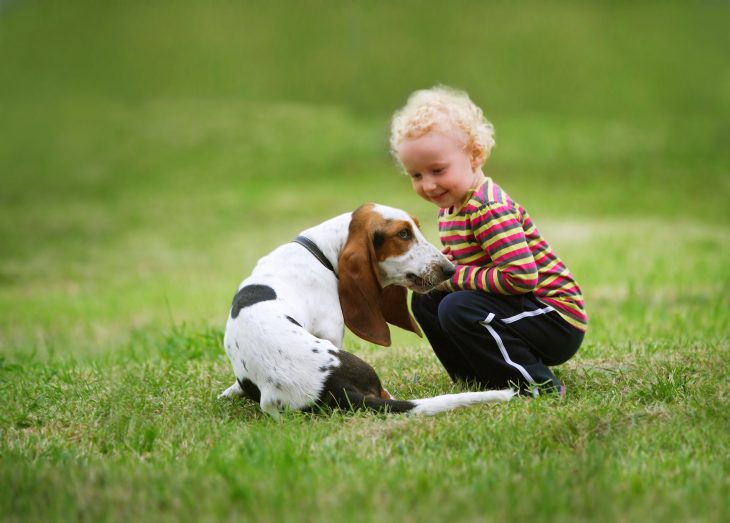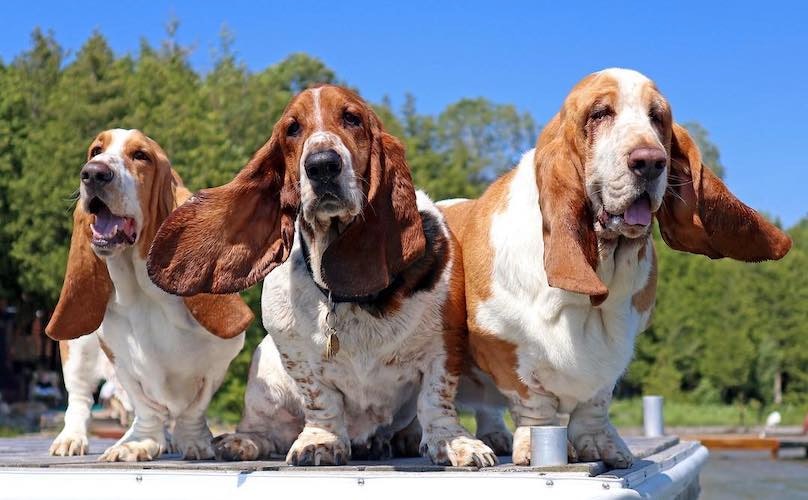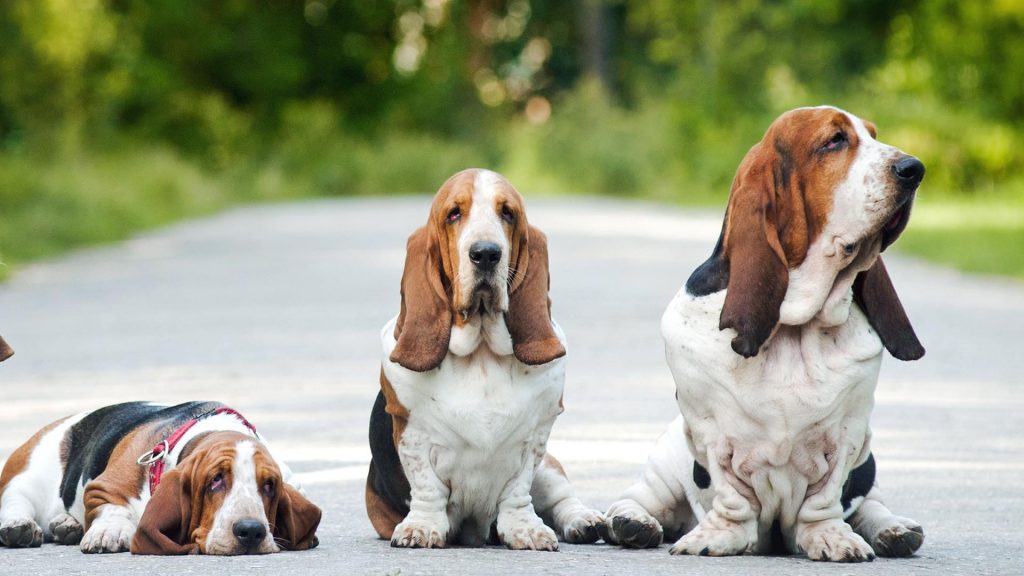The Basset Hound dog is famed for its “Hush Puppies” appearance but it is more than just the face of a brand.
The name Basset Hound comes from the word ‘bas’ in French which means low, befitting the low posture that the Basset has.
They are excellent hunters and have an impressive sense of smell.
They may be short but have the strength of large-sized dogs.
They were initially bred to hunt small animals such as rabbits, mice etcetera and are still used for the same in most parts of the world. But they have also found a home in many families due to their loving nature.
Table of Contents
Basset Hound Pictures
Basset Hound Facts

Avg. Weight: 23-29 kg (Male), 20-27 kg (Female).
Avg. Height: 30-38 cm (Male), 28-36 cm (Female).
Life Expectancy: 10-12 years
Dog Group: Hound
Colors: Lemon & White, Black & White, Tri-color, White & Chocolate, Black & Brown, Red & White.
At A Glance
Size (2/5)
These are moderately heavy dogs. The Basset Hound weight for males is about 23-29 kgs standing 30-38 cms tall whereas the female counterparts are 28-36 cms tall weighing 20-27 kgs.
Before you bring a Basset Hound home, you should know that they are very heavy dogs despite their size.

So if you have a two-story house, it may become difficult for the Basset in its old age to climb stairs and you will have a hard time carrying it upstairs.
Affection Level (2/5)
They are known for their extremely tolerant behavior, calm and collected temperament and affectionate nature towards their family.
Basset Hounds make great family pets. They are loving and caring; they easily form individual bonds with family members and are very possessive of them.
Apartment Friendly (2/5)
With the right training and car, these sloppy eared pooches make great compliant partners.
They do not require tedious grooming and care, thus they make the best fits for urban residents.
Their adaptability is excellent and they can live in apartments or perhaps smaller spaces too.
Cold Weather Tolerability (2/5)
Bassets do not do well in cold weather. They can live in mildly chilly areas but it is not advisable in extremely cold temperatures.
If you are living in an apartment make sure your dog is warm and cozy in the winters.
Do not leave them out for too long in the cold or snow. Also, they love to wear sweaters, so you can play dress-up with cute Christmas sweaters!
Hot Weather Tolerability (2/5)
Their soft and shiny coat does get them through most seasons without any trouble.
However, if it is too hot in the summers, you should keep your Basset inside your house. They do not respond well to extremely hot temperatures.
It may affect the health of the Basset Hound adversely.
Barking Tendencies (4/5)
Bassets are not known to be chatty but they do get lonely if left alone for long periods in the day.

So, it is best to be with him for most of the day.
They start howling and barking too loud, when in solitude, as a call for their owners or company. This may create problems for neighbors, who might raise an issue.
Cat-Friendly (4/5)
If you’re looking for a Basset Hound to be a part of your family and you already have a pet cat, you can go ahead and get one.
Dog-Friendly (5/5)
Extremely tolerant and unbothered, to be candid, the Basset Hound temperament is perfect for having other dogs in the family.
Bassets are rather loving and caring then spiteful; they welcome other dogs and make very co-operative pets.
Exercise Needs (2/5)
Basset Hound exercise needs are moderate and do not require much of your time.
A 20-30-minute walk should suffice, a few games of fetch and you’re good to go.
However, you must take your Basset out on the walk daily as it will keep them healthy, will prevent any bone/joint diseases and will also keep them mentally active.
Grooming Needs (1/5)
Despite the short hair, you will have to brush it regularly to avoid any kind of matting from prevailing.
The usual bathing, nail clipping, and brushing comprise of the Bassets grooming routine.
Cleaning the ears, the eyes and the teeth are also vital to maintain good health.
Playfulness (2/5)
These dogs are very low-maintenance. They are always low on energy, lethargic and not very playful.
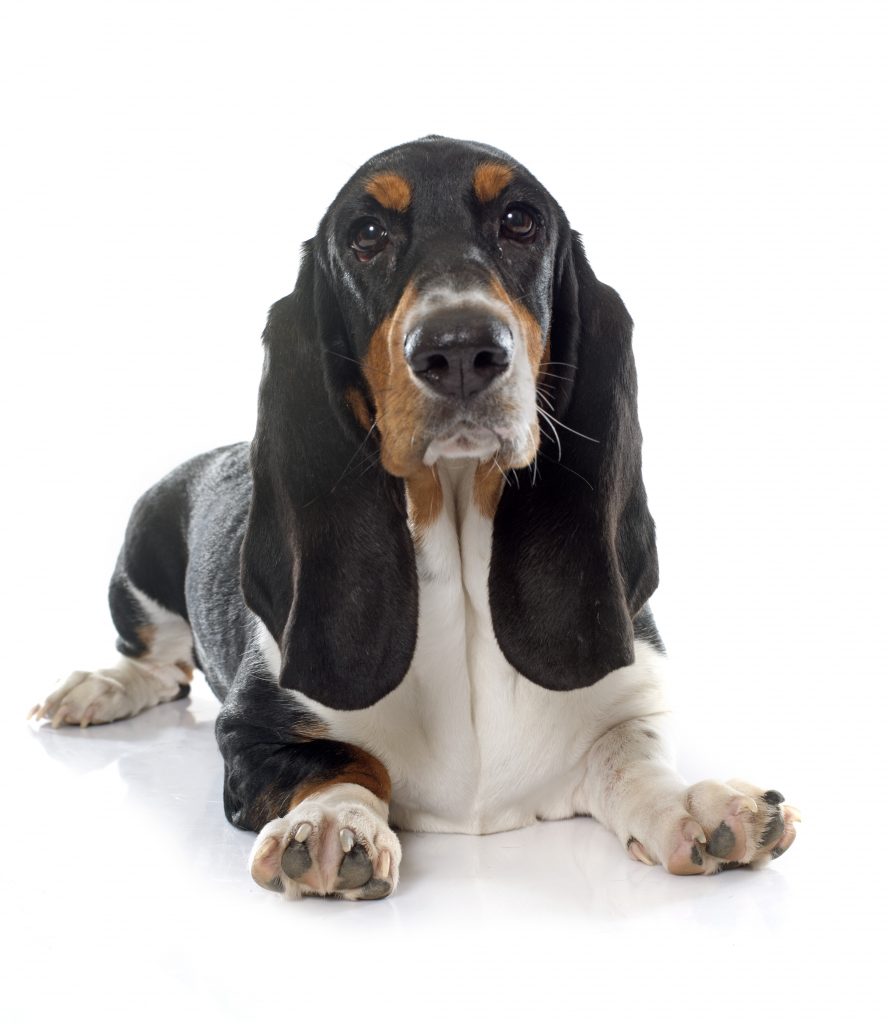
They are also extremely slow walkers so this might make daily walks longer than they already are.
Trainability (2/5)
Basset Hound training is a very tedious and hard task.
But if you are patient, you can hope for your basset to come around.
Intelligence (4/5)
Bassets are very smart indeed but they are also known to have a mind of their own.
This can make them difficult to train.
Mouthiness (4/5)
Even though this breed is not highly energetic, they are prone to chewing.
Bassets also drool a lot which is a task to clean up after.
Price Group (3/5)
The Basset Hound price averages anywhere from $1,200 to $1,500.
About Basset Hounds

Basset Hounds are caring, loving and quite laidback in nature.
Initially bred to become small game hunters, chasing rabbits, they are now lazy family dogs that will not move an inch if there is no incentive.
They have long ears and big, sad eyes that make them look sorrowful and serious at all times.
Bassets are very friendly towards strangers; they are very welcoming and acquainted with other dogs and pets.
The average Basset Hound lifespan is of 10-12 years.
Dogs Monthly says they are Long, Low and Loyal.
Where Basset Hounds Came From?

The Basset Hound originated in the sixth century in France.
France is known for its creation of many hounds.
Most of these hounds had tall versions and short versions too, which were under sixteen inches.
“Bas” translates to low in French. Thence, the name Basset Hound.
Basset Hounds and it’s long-legged cousin, Bloodhound, are descendants of the famous St. Hubert hounds.
The long ears of the Basset helped him stir up scents, hence, packs of Bassets used to drive small prey from dense forests to open ground so that they could be shot by hunters.
Till today, Bassets are used for the same in the countries of England and France.
Size
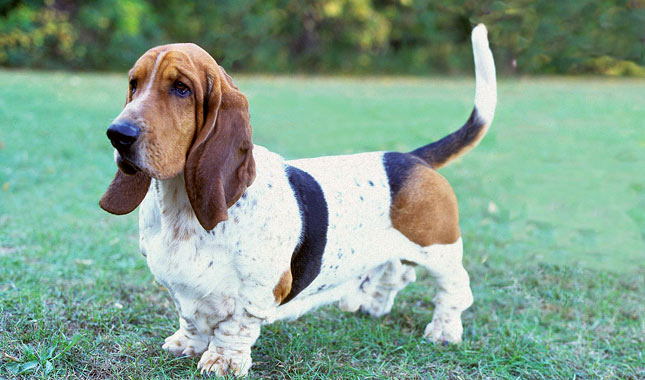
The Basset Hound size is moderately small. They have short legs but are very heavy inbuilt.
An average-sized Basset male stands approximately 35 cms tall weighing 26 kgs and a female Basset is 32 cms tall weighing 23 kgs.
So basically, they are big dogs on short legs.
The unusual body composition of the Basset Hound is a form of dwarfism called Achondroplasia.
Bassets are bulky dogs and short in height, this makes them slow maturing dogs. More often, they do not reach their full size until they are two years old.
They are easily recognizable because of their short and crooked legs, large heads with long hanging ears and wrinkled foreheads.
The tail is gaily and it curves up; the body is short and that gives the basset a rectangular appearance.
The common Basset Hound colors are tricolor, red or white, white and black etcetera.
Trainability

Basset Hound dogs are not ones to train. They are extremely stubborn dogs, emphasis on the extremely.
Bassets will not adhere to basic commands like “no” and “come here”.
They have an independent mind of their own which sometimes will work against you.
Especially if you are trying to train him.
Bassets are listed among the top 15 stubborn dogs by Top DogTips.
All said and done, you will need to maintain your patience and temperament to establish a connection with your Basset, who is extremely loving but also obstinate.
Grooming

Basset Hounds are easy to groom but because of its unusual body structure you may have to take a little extra care of your basset.
You can bathe your basset as regularly as you wish, with a dog shampoo. Thorough rinsing is important.
You should avoid getting any shampoo inside the ears or the eyes of the Basset, so make sure you place some cotton balls inside the ears.
Nail clipping for Bassets must be done every 10 to 14 days to avoid any problems such as soreness or stress on the feet.
You can take your Basset to the vet regularly or ask the vet to teach you how to clip the nails.
You should brush your Basset’s teeth regularly and check for any plaque or tartar formation.
The long ears of the Basset do not allow any circulation of air; making it prone to infection. You can clean the Basset’s ears once a week with a mild astringent.
Because of its droopy haw, the Basset Hound eyes are prone to irritation. They should be cleaned regularly and carefully.
Common Diseases
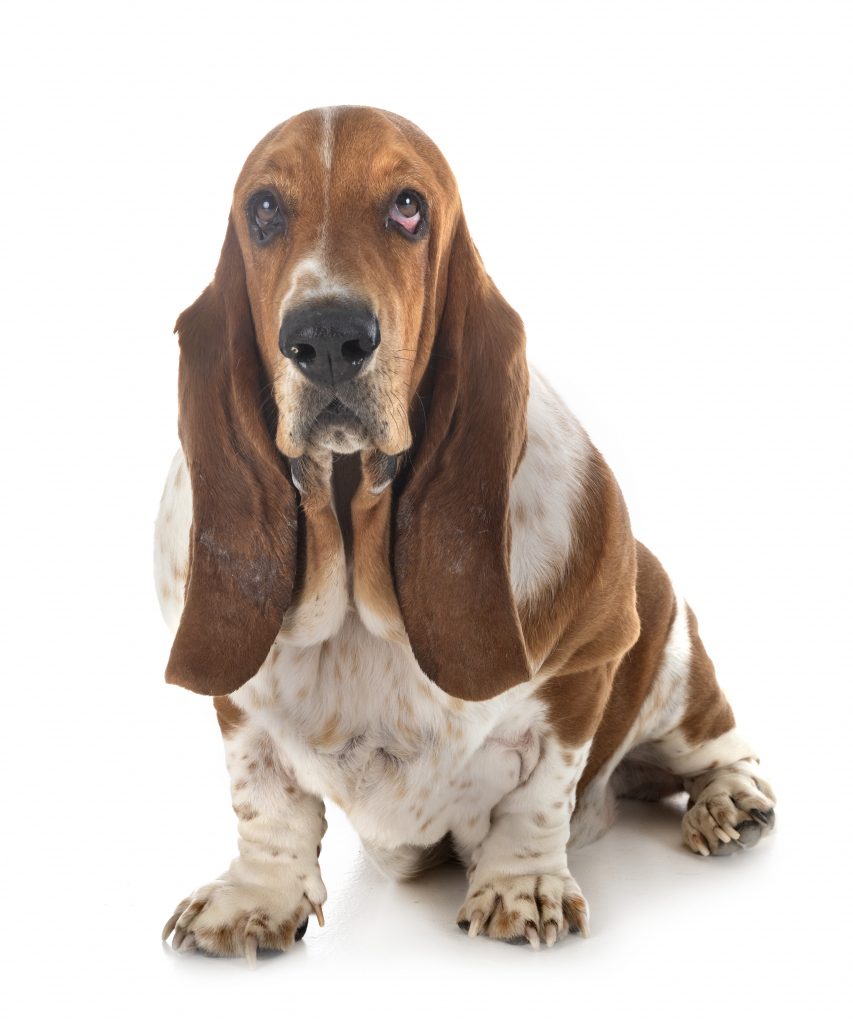
The Basset Hound health is quite sound, not all Bassets have these diseases but if you are going to adopt/purchase one, you should be aware of the diseases they are prone to.
TARGETING THE BONES
PATELLAR LUXATION
This disease is also known as “slipped stifles”, which is very common in most dogs.
The patella has three parts – the thigh bone, knee cap, and the calf. When these three are not in line, it can cause patellar luxation.
This could cause lameness in the leg or gait. This condition prevails at birth although the misalignment does not occur until much later.
Having this condition could lead to arthritis, a degenerative joint disease.
HIP DYSPLASIA
This condition is very common in Bassets.
This deformity in the hip joint could be a result of factors such as genetics, environment, diet etcetera.
This condition is heritable. This could affect daily life; movement may be painful for the Basset.
This could be treated with some medication or in severe cases, surgery might be required.
PANOSTEITIS
This is also called Wandering or Transient Lameness. This elusive ailment that is sometimes seen in young Basset Hounds.
Its primary sign is sudden lameness and a Basset Hound puppy usually outgrows this problem.
The severity of the lameness can vary. Most vets often misdiagnose this condition with hip dysplasia or elbow dysplasia or some other more severe diseases.
If misdiagnosed, the vet could perform a surgery on your Basset that is not required.
TARGETING THE EYES
CHERRY EYE
This condition occurs when the gland beneath the third eyelid protrudes and looks like a cherry in the corner of the eye.
Your vet may have to remove the gland.
GLAUCOMA
This condition is very common in Basset Hounds.
Glaucoma is a disease where pressure builds up inside the eye.
If not detected and treated early this condition could lead to blindness.
Take your basset to the vet if you notice him squinting, tearing or rubbing his eyes.
EYELID AND EYELASH PROBLEMS
Bassets are prone to the turning out of the eyelids also called in ectropion, resulting in a dry cornea causing the lashes to dig into the surface of the eye.
Removal of this problem can be done surgically, consult the vet as soon as you see signs of this in your Basset.
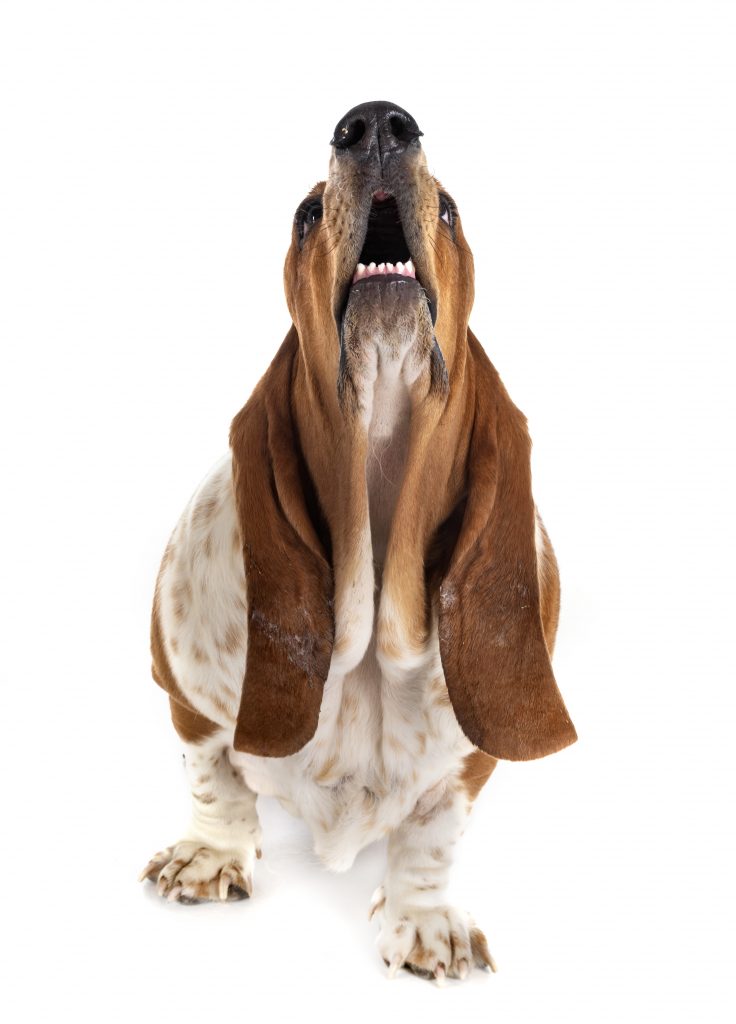
TARGETING THE BODY
Gastric Tension
This is a life-threatening situation that can affect large and deep-chested dogs like Basset Hounds.
This could arise if they are fed large meals or they eat rapidly or they drink too much water after eating.
This condition also called “bloat”, is common among other dogs.
It occurs when the stomach is distended with gas or air and then twists.
The dog is unable to vomit, to get rid of the excess air in the stomach. Blood pressure drops severely and the dog has a concussion.
If the dog isn’t taken to the vet, it can die.
Check for a bloated stomach or excessive drooling. Your dog could be breathless, depressed and lethargic. If you see these signs, call the vet immediately.
EAR INFECTIONS
The Basset has long ears that do not allow sufficient air circulation to the inside of the ear.
This could lead to the development of infections inside the air.
To prevent this, you should clean their ears, every week. Take your Basset to the doctor if the ears smell weird or seem inflamed.
OBESITY
This is a serious problem for long-backed breeds just like the Basset.
You should find out how much you need to feed your dog and stick to the portions to regulate the Basset Hound health.
Feeding
An average Basset needs 1700 calories daily to sustain himself. But be careful as to what you are feeding your Basset as they are not active dogs.
If you feed your Basset too much, it could become obese.
Suggested: Senior Dog Food
Feed him twice a day and in moderate proportions. Try to stick to this routine. But if you forget dinnertime, your Basset will remind you anyway!
You can feed him dry kibble food or home-cooked food such as raw meat with white rice.
If you need help with Homemade Dog Food, click here.
Vaccination And Care
:max_bytes(150000):strip_icc()/basset-vet-Stockbyte-Jupiterimages-GettyImages-86495329-569bc3c93df78cafda96aded.jpg)
Distemper vaccine
This severely affects the organs of the Basset Hound such as the spinal cord, respiratory system, brain, and intestines.
The common symptoms of having distemper are high fever, lethargy, loss of appetite, etc.
Pravo
This disease spreads through the infected dog’s hair or feet. It is fatal.
Basset Hounds are prone to this virus.
Signs that your dog could have this are bloody diarrhea, depression, vomiting, fever, etc.
Rabies
This is a very damaging virus; it deteriorates the brains of all mammals.
Dogs secrete large amounts of this virus in their saliva and thus, a dog is infected with rabies when it is bitten by another dog.
Signs that a dog has rabies can be seen in behavioral changes such as restlessness and aggression. They become hypersensitive to touch, light, sound, etc.
Hepatitis
Infectious canine hepatitis is a very serious condition caused by a highly infectious virus that affects the liver.
It develops extremely quickly in puppies and dogs.
Symptoms of hepatitis are vomiting, lethargy, fever, abdominal pain and an enlarged liver.
Vaccination can be a huge field to cover. Read our Guide To Dog Vaccination to have a better understanding of how vaccines work in dogs.
Monthly Expense Estimation
The average monthly expense for a Basset Hound is $100.
Behaviour

Children:
Bassets make the perfect companions for a child in search of a playmate. Bassets are very kind and well-natured.
You can trust them with your children, they are very playful.
Their silly antics will provide you with hours o entertainment. Having a child at home will be better for the Basset as they love to be playful and active.
Having a basset at home could really help enrich family life.
Dogs:
Basset Hounds get along with other dogs very well. They are not competitive or aggressive which makes them receptive to other dogs.
Cats:
Fortunately, Basset Hounds are very friendly and receptive to cats too.
They are slow-moving, low and quite calm which are perfect traits for living with cats.
However, you should monitor your cat’s behavior and take care accordingly.

Overview
Basset Hounds are easy-going, very friendly dogs that make perfect companions for families.
They have a very laidback attitude towards physical activities but they are playful whenever they want to be.
They are not easy to housebreak; you really have to have the patience to train your Basset because they are very obstinate.
They are very trustworthy with children; they get along with other pets and cats too.
They have a very strong sense of smell; they were companions of hunters back in the 16th century.
They are very loyal and are best suited for apartment living.
Something Fun About Basset Hounds

- Basset Hounds are the second-best sniffers in the canine kingdom after their long-legged cousin the Bloodhound.
- Their long ears trap smells and help them pick up smells.
- They have a lot of trouble swimming.
- They are considered the most melodious breed.
- Marylin Monroe had a Basset Hound.
This was all about Basset Hounds.
Let us know about your thoughts in our comment section!
Stay with us to know more about dogs and dog breeds.



